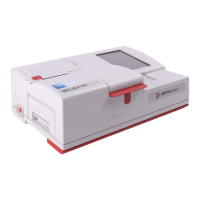Operator’s Manual – OPTI CCA-TS2 9-3
9 OPERATING PRINCIPLES
9.4 Specimen Collection and Handling
9.4.1 Safety
Universal precautions must be observed when collecting blood specimens. It is recommended that all
blood specimens be handled as if capable of transmitting human immunodeciency virus (HIV), hepatitis
B virus (HBV), or other bloodborne pathogens. Proper blood collection techniques must be followed in
order to minimize risk to the laboratory staff, and gloves should be worn. Please refer to CLSI document
M29-A3, ProtectionofLaboratoryWorkersfromOccupationallyAcquiredInfections,Approved
Guideline-ThirdEdition; March 2005, for further information on safe handling of these specimens.
9.4.2 Sample Requirements
Refer to CLSI document H11-A4, ProceduresfortheCollectionofArterialBloodSpecimens;Approved
Standard-FourthEdition; September 2004, for detailed information on sample collection, storage and
handling.
Blood sampling for analysis must be performed under proper medical supervision with details of
collection, including sampling devices, site selection, sample handling documentation and specic
procedures used approved by the personnel responsible.
9.4.3 Anticoagulants and Sample Collection Devices
Lithium heparin is the only acceptable anticoagulant for blood gas and electrolyte analysis. Lithium
heparin, sodium heparin or balanced heparin salts are the only acceptable anticoagulants for blood gas
analysis. Other anticoagulants such as EDTA, citrate, oxylate and uoride have a signicant effect on
blood pH and electrolyte levels and should not be used. Lithium heparin should not be used for samples
taken also for analysis of lithium
.
9.4.4 Syringes
If liquid heparin is used as an anticoagulant, collection devices should be no larger than the amount of
blood required to minimize the effects of dilution of the blood by the anticoagulant solution. Although
plastic syringes are commonly used for collection of blood specimens for blood gas analysis, there have
been reports in literature regarding the use of plastic syringes when PO
2
values higher than normal are
expected. Particular attention should be paid to cooling blood samples in ice water, because of the CO
2
and oxygen solubility in some plastics. If blood specimens are expected to have very high PO
2
values,
care should be taken to analyze the specimen as quickly as possible following collection to avoid the need
for cooling. Attentionshouldbepaidtothoroughmixingofwholebloodsamplespriortoanalysis,since
sedimentationofbloodcellsaffectsthemeasurementoftotalhemoglobin.
9.4.5 Capillary Tubes
Capillary blood specimens should be collected using capillary tubes which have a minimum volume,
lled, of 125 µL. The OPTI Medical capillary tubes (MC0024) are ideally suited with a minimum
volume, lled, of 200 µL. The capillary tubes for pH, blood gas, and electrolyte analysis should not be
used for samples taken for the analysis of lithium.

